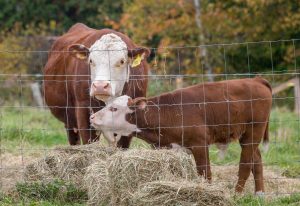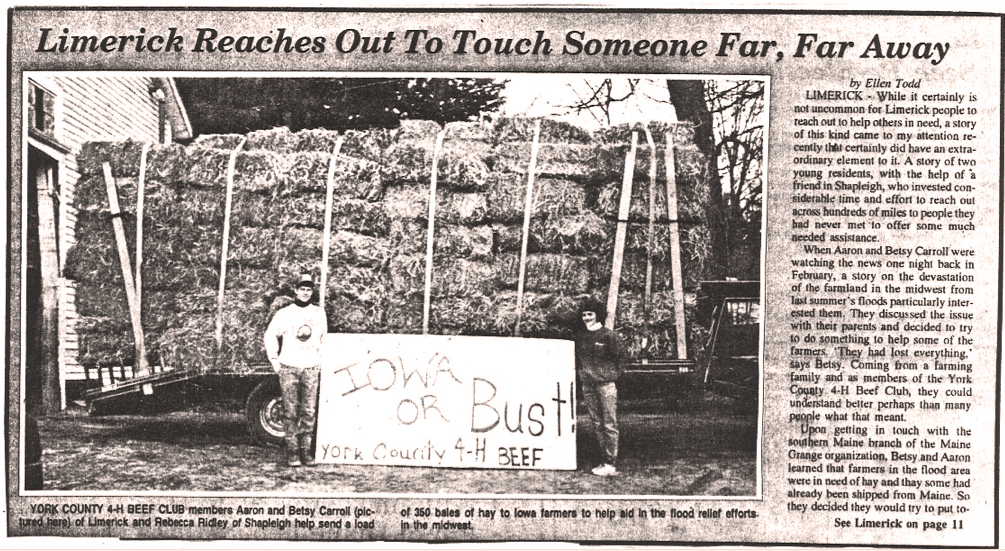4-H Fix: The Great Hay Relief of 1994
The Great Hay Relief of 1994
By Ron Drum, Statewide 4-H Program Professional/Associate Director 4-H Resource Development
 It happened in 1993. The National Oceanic and Atmospheric Administration (NOAA) called it “the largest and most significant event ever to occur in the U.S.” It affected nine mid-west states: North Dakota, South Dakota, Nebraska, Kansas, Missouri, Illinois, Wisconsin, and Minnesota, with Iowa sitting right in the middle. Fifty people lost their lives. Tens of thousands of people were evacuated from their homes, many never to return. At least 10,000 homes were destroyed. At least 75 towns were at some point totally under water. At least 15 million acres of farmland were inundated, some still unusable yet today! Damage was estimated to be at least $15 billion with some estimates as high as $30 billion or more.
It happened in 1993. The National Oceanic and Atmospheric Administration (NOAA) called it “the largest and most significant event ever to occur in the U.S.” It affected nine mid-west states: North Dakota, South Dakota, Nebraska, Kansas, Missouri, Illinois, Wisconsin, and Minnesota, with Iowa sitting right in the middle. Fifty people lost their lives. Tens of thousands of people were evacuated from their homes, many never to return. At least 10,000 homes were destroyed. At least 75 towns were at some point totally under water. At least 15 million acres of farmland were inundated, some still unusable yet today! Damage was estimated to be at least $15 billion with some estimates as high as $30 billion or more.
It became known as Great Flood of ’93:
Video: KSDK, Great Flood of ’93, October 1993
After a wetter than normal fall and winter, the snow that had piled up through the winter began to melt in the spring. Then, in April, it began to rain, and the lakes and rivers began to fill up, and then it began to flood. The rains did not let up. Torrential rains through the summer just made matters worse. It didn’t completely let up until October. Between April and August East-Central Iowa alone, a place that would normally see 30-36 inches of rain, saw 48. In July alone, a month that Iowa usually can count on having 8 or 9 days with rain, experienced 20 days of rain. Between mid-April and September, except for 13 days, it rained somewhere in Iowa every day — a total of 130 days! Thankfully, after August, the Iowa weather began to return to normal, even becoming drier and cooler than normal by late fall, winter, and following spring of 1994.
But by then the damage was done. It hit the Iowa farmers particularly hard. They had livestock to feed and nothing to feed the livestock with. The Iowa State Grange put out a call for help. It was, of course, a story carried by all of the news outlets.
Aaron and Betsy Carroll, teenaged members of the York County 4-H Beef Club, were sitting in their Limerick, Maine home watching the TV news one February evening in 1994 when the story concerning the plight of the Iowa farmers came on the TV screen. They watched quietly. Then they said what might usually be said after seeing such a story, “Oh that’s terrible!” “How will they survive?” “Somebody ought to do something!”
Then the conversation took an unusual turn. “Maybe we ought to do something! Maybe we could send them some of our hay!”
Crazy idea? Perhaps. One doesn’t just dial up a shipping service and say, “I have some hay to ship to Iowa!” In fact, Aaron and Betsy did NOT have a lot of hay just sitting around waiting to be sent to Iowa even if such a thing might have been an easy thing to do! No one in Maine did! While Iowa and the other mid-west states were seeing unusually wet, to say the least, conditions in 1993, Maine’s summer of 1993 was unusually hot and dry, not conditions suitable for a good hay crop. Farmers in Maine were also facing a shortage of hay in the spring of 1994, albeit nothing like that of Iowa’s.
Aaron and Betsy talked it over, then they talked about it with their parents and were told, “Yes, we’ll help.” They talked it over with their 4-H club leaders, Elwood “Woody” and Mary Brown, and they said they’d help. They told their 4-H Club about it and the club members said that they would help. They talked it over with the County 4-H Office and the State 4-H Office and with the Maine State Grange. “Yes, we’ll help.”
So Aaron, Betsy, and fellow 4-H member, Rebecca Ridley of Shapleigh, began to plan how they could make this happen. They set a goal of 60 bales, one pick-up truck full. By the end of their first meeting with their 4-H Club to describe their plans, their goal was met!
Encouraged by this success, they decided to keep going and see just how much hay they COULD get for the Iowa farmers! They started contacting local farmers in Southern Maine; farmers, remember, facing their own hay shortage. Most of them pledged some of their hay to this cause. Some who couldn’t offered a contribution. Other people did too. The Riverdale Riders 4-H Club of Biddeford sent a most welcome $20 contribution. York businesses contributed as well, calling the effort “a very worthy cause.”
Gathering pledges of hay was one thing. Gathering the actual BALES of hay was quite another. In Betsy’s words, “It took many endless evenings to get all the pick-up arrangements made. The hay was then loaded on two pick-up trucks and also on to a trailer that held the majority of the hay. At final count, we had raised three hundred and forty-five bales.” Betsy told me, underscoring the difficulties of all the logistics these teens overcame, including a near blizzard on the day the hay was to be loaded, “Aaron and I both have come to the realization that neither of us has any intention of becoming a freight terminal dispatcher.”
Now they had their hay. Now they had to get the hay to Iowa. The Maine State Grange was helping them do that as part of their own effort to collect bales of hay for the Iowa Hay relief. Aaron reported that “Dave Burnham (Maine Rototilling of Scarborough and coordinator of the Maine Grange’s hay relief effort) has donated the first trailer of 635 square bales which will be hauled by RC Moore of Scarborough. This trailer will arrive Iowa on Valentine’s Day. Dysarts Trucking has also volunteered to haul additional loads.” In all, the Grange effort sent 6,600 bales of hay to Iowa.
This total included, in addition to the 345 bales acquired by the three 4-H’ers, 30 bales that were collected by the members of the Rockinghorse Riders 4-H Club of Saco. Their 4-H Club Leader, Nan Schildroth, reported that the club had accepted the York County 4-H Beef Club’s challenge to collect bales of hay, voting to send one bale of hay for each member in the club, the members each paying for their bale out of their own pocket. These 30 bales, plus bales donated by three other 4-H Clubs who answered Aaron’s challenge, filled an additional trailer.
 The 4-H Beef Club’s 345 bales departed Maine on March 23 and arrived in Grinnell, Iowa on March 26. Betsy, wanting to close the circle, called the Iowa State 4-H Leader to see if an Iowa 4-H Club could receive the 4‑H Hay and help distribute it “therefore giving us a sense of national 4-H unity”! He connected her with Larry Iverson, a member of a 4-H Club in Montezuma, a club of boys who focused on poultry and beef projects. The evening of March 23, as the hay began its journey toward Iowa, Betsy appeared on the Channel 13 TV news and told the story of the great 4-H hay relief of 1994. It would not be the last time she’d be featured on TV for this project.
The 4-H Beef Club’s 345 bales departed Maine on March 23 and arrived in Grinnell, Iowa on March 26. Betsy, wanting to close the circle, called the Iowa State 4-H Leader to see if an Iowa 4-H Club could receive the 4‑H Hay and help distribute it “therefore giving us a sense of national 4-H unity”! He connected her with Larry Iverson, a member of a 4-H Club in Montezuma, a club of boys who focused on poultry and beef projects. The evening of March 23, as the hay began its journey toward Iowa, Betsy appeared on the Channel 13 TV news and told the story of the great 4-H hay relief of 1994. It would not be the last time she’d be featured on TV for this project.
They made the front page of the Sanford News as well!

On April 28, Larry reported to Betsy and Aaron, “The farmers on this end were very glad to receive the hay. The Iowa State Grange made all the arrangements to distribute the hay. Some of the hay didn’t even stay in our part of the state. Two trailers came from northeast Iowa (2 ½ hours) to get hay for their dairy farms. The Grange director in charge of this project is from Grinnell was why the hay came here. Some of the hay stayed in our area but Dairy farms had first priority and northeast Iowa is big in Dairy. Our area is known for beef herds, corn, soybeans, hay (usually), and hog production.” It was apparent these three Maine 4-H’ers had really made a difference.
Maine State Grange Master Clyde G. Berry, concerning the Grange Hay Relief project of which the 4‑H’ers had become a part, said, “Our contacts in Iowa can’t believe the support that they have received from this northern New England state.” He went on to say, “We hear so much about how selfish people are today, but we have found you folks so very generous.” Chuck Routier, the Iowa State Grange Flood Relief Chairman, commented, “I just wish you could have been here to see the expression on the faces of those who received the hay and (hear) the comments that were made.” Then he added, “GOD BLESS YOU ALL.”
On May 19, the Sanford News reported:
“Many readers may remember the front page picture and story on Aaron and Betsy Carroll that ran in the Sanford News on April 12. …Their 4-H Club Leader, Mary Brown, unbeknownst to the three of them (referring to Aaron, Betsy, and Becky), submitted their names for Channel 6 as candidates for America’s Future Awards and they were one of the six groups of young people in the state chosen for the award.” Aaron, Betsy, and Becky appeared on Portland’s WCSH (NBC) Channel 6 in a special 7:00 p.m., May 26 America’s Future Awards presentation to receive this honor.
The project made a difference for the 4-H’ers as well. Again quoting Betsy, “After speaking with the 4-H Director in Iowa, I knew that we had done a world of good. Not only had we brought our community in rural Maine to help those in need, but we had also made a real difference to a town in Iowa.”
Then, in her typical unselfish style, she added, “What a great accomplishment for the York County 4-H Beef Club.”
Check the 4-H Fix on October 21 for our next post: Mainer’s in the National 4-H Hall of Fame.
Have you been a part of a 4-H project that made a difference in someone’s life or, perhaps, been the recipient of someone’s good deed toward you? If so, big or small, tell me about it and perhaps your story will appear in the “4-H Fix”!
Were you a 4-H Member?
 UMaine 4-H wants to hear your story. Please take a moment to fill out our short form and Tell Us Your Story!
UMaine 4-H wants to hear your story. Please take a moment to fill out our short form and Tell Us Your Story!
University of Maine Cooperative Extension conducts the state’s most successful out-of-school youth educational program through 4-H, a youth development program that has been empowering young people in Maine to reach their full potential since 1913.

